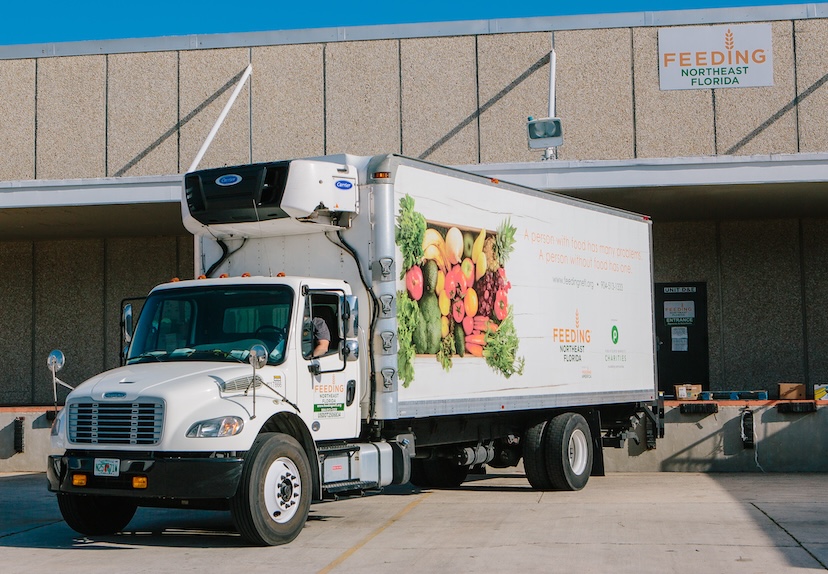Food pantries play a pivotal role in addressing hunger and food insecurity in our communities. While we often appreciate these organizations’ impact in distributing food to those in need, a fundamental question remains: Where does the food in these pantries come from? Let’s delve into the intricate web of sources that sustain our local food pantries.
Before we can fully answer where the food at food pantries comes from, we need to define and explain the difference between two terms often used interchangeably: food bank and food pantry.
What Is a Food Bank?
A food bank is a non-profit organization that safely stores and prepares millions of pounds of food to be shared with the community.
Feeding Northeast Florida is a food bank. Last year, we acquired and distributed more than 30 million pounds of food to communities in the twelve counties we support. Our organization is staffed by employees and volunteers who sort and deliver food. Generally, this food is delivered to food pantries and feeding programs, which host weekly distributions throughout North Florida.
What is a Food Pantry?
A food pantry is a distribution center where individuals and families facing food insecurity can receive food. Food pantries are typically located in community institutions like churches and schools. Most food pantries have regularly scheduled distribution days so the hundreds of people they serve in the community know when they can show up to receive the nourishment they need.
Most food pantries are staffed by volunteers committed to caring for their neighbors. Some pantries have a drive-thru setup where fresh, healthy food is placed into vehicles. Other pantries offer a shopping experience where individuals and families can choose the items they need. All pantries provide a dignified experience for those who are acquiring food.
Where Does the Food Come From?
At the highest level, food banks receive the food for distribution to food pantries from three sources: donations, purchases, and federal programs.
Donations
Donations are the source of most food received by individuals and families struggling with food insecurity. These donations come from multiple channels, including:
Farmers
Food banks develop partnerships with farmers of all operational scales who donate crops they cannot sell for various reasons. These partnerships foster healthy food distribution to neighbors who may not otherwise have access to fresh produce. Reducing food waste is another benefit of these relationships, allowing farmers to donate crops that do not go to market.
Companies and Local Businesses
Food banks receive donations from large and small food distributors. These donations can range in scale from a truckload of milk to a few extra loaves of bread. Types of items can include non-perishables like canned goods or high-demand fresh items like meat and eggs.
Food Drives
Food drives are an excellent source of high-quality, shelf-stable items for food banks. Schools, churches, and businesses generally organize food drives to provide an opportunity to multiply individual contributions.
Anyone can lead a food drive. Click here to learn how your organization can get involved.
Purchases
Food banks buy the necessary food items that their communities require but haven’t been obtained through donations. Partnerships with local and national suppliers give food banks the same buying power as a grocery chain. These partnerships enable donated dollars to purchase more for less than an individual can buy on their own.
Purchasing also enables food banks to acquire items not donated regularly, like culturally or medially particular foods.
There are many ways you can donate to Feeding Northeast Florida. Click here to find ways to contribute to support the fight against food insecurity in our area.
Federal Programs
The United States Department of Agriculture (USDA) is a driving force in providing meals to individuals and families facing hunger in our communities. Supporting programs like The Emergency Food Assistance Program and The Community Supplemental Food Program, the USDA supplies tremendous support directly to food banks to support healthy eating for parents, kids, and senior citizens in need.
Through these and other programs that benefit farmers and our community, the administration delivered more than 1.2 billion meals last year.
Food insecurity is a huge problem, impacting every county in the United States. Feeding America reports that 44 million people in the United States face food insecurity. No single source or supplier could tackle the issue alone. It takes compassion and partnerships from individuals, communities, and governments to address hunger. Thankfully, so many are willing to do their part.
Feeding Northeast Florida and our volunteers are on the front lines daily as we distribute food from 495 pantries where they are needed most in our communities. These pantries cannot feed the parents, children, veterans, and seniors who require assistance without the help of our community.
If you can help, please click here to find ways to donate or volunteer. If you need help, it is available. Click here to find food near you.







